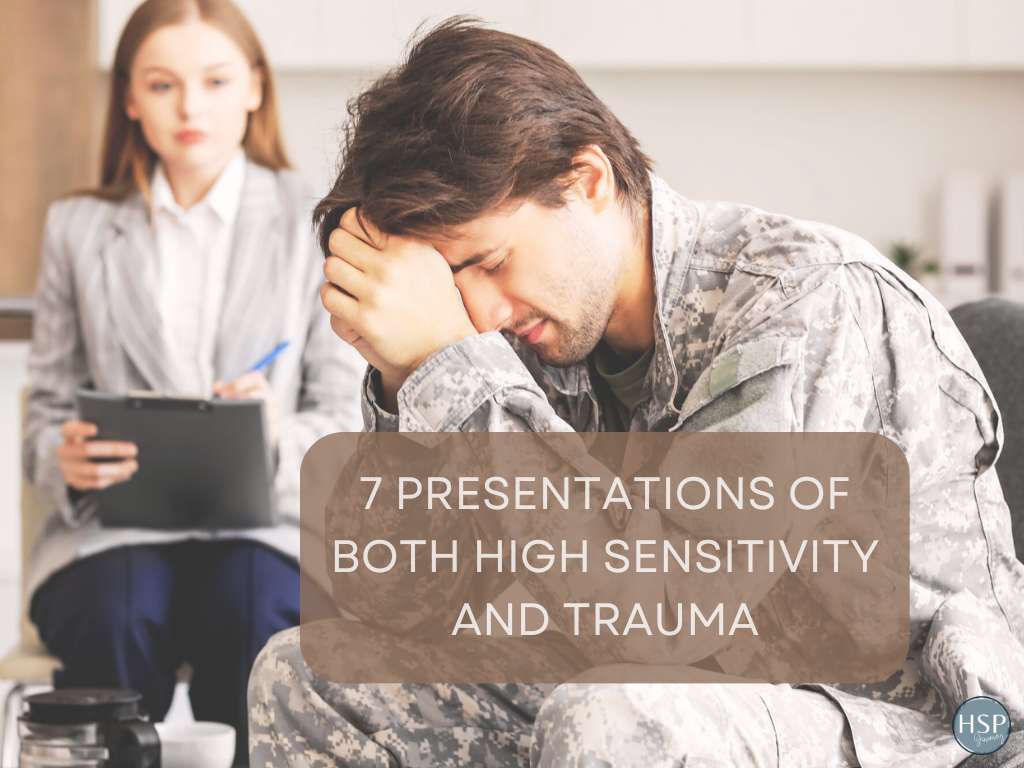There’s a segment of the population that experiences life more vividly, more emotionally, and overall more sensitively. These highly sensitive persons (HSPs) exhibit distinguishable characteristics, many of which are similar, if not seemingly identical, to symptoms of trauma. For HSPs with a background of trauma, one question understandably arises: Can trauma cause high sensitivity? In this article, we’ll look at seven presentations of both high sensitive and trauma to see if we can shed more light on these topics.

Table of Contents
The relationship between trauma and high sensitivity isn’t a straightforward yes-no, or causal relationship, either. And that’s in part because of overlap in the semantics of “high sensitivity.”
In short, “high sensitivity” as a trait is not the same thing as “high sensitivity” from trauma, despite their similarities and overlap.
And yet, descriptions of the two often focus on the manifestations of neurological sensitivity and not the origins of it. For clarity and distinction, I think of those origins as holding the key to understanding 3 “types” of high sensitivity:
- High sensitivity as an innate trait (think of Dr. Elaine Aron’s highly sensitive person)
- High sensitivity as a result of trauma (PTSD and especially developmental trauma, or Complex PTSD)
- “Trait-plus-trauma” high sensitivity as a result of trauma to the highly sensitive child or adult
- The highly sensitive person brain vs. the traumatized person brain
An HSP’s brain is not ‘defective.’ It is not ‘mis-wired,’ and it doesn’t need ‘healing.’
It is, however, unique compared to the brains of non-HSPs.

Looking for an HSP-Trained coach to help you align your life with your priorities?
Through my Highly Sensitive Person (HSP) certification with the Nickerson Institute, as well as being an HSP, I offer HSP coaching to develop specific goals around your HSP needs. We HSPs frequently deal with anxiety and overstimulated nervous systems that prevent us from achieving peace and attaining our life goals. HSP coaching with me includes a detailed review of your sensitivities and a mutually-desired plan for growth and management of this superpower to shift negativity and begin seeing yourself as the hero of your own story.
Notably, the HSP’s brain has increased activation of regions involved in attention, action planning, awareness, integration of sensory information, and empathy. It senses, feels, and processes greater amounts of stimuli – and more deeply – than does the non-HSP brain.
What makes the highly sensitive brain unique is that it is, for all intents and purposes, “always on.” It doesn’t have the protective filters of the non/less-sensitive brain that would otherwise allow selectivity of incoming information. It’s like an open-invitation host in that regard.
In the traumatized developing brain, on the other hand, priority of neural pathways is deferred to dealing with the trauma. Normal neurological development becomes subordinated.
Consider that the brain reaches 80% of its full size by age three and 90% by age five. Throughout childhood and adolescence, there is selective “pruning” and myelination of neural pathways for increased efficiency, protection, and strength. Pathways are both discarded and locked in.
On a positive note, the brain has its greatest plasticity during infancy and childhood. That gives a window of opportunity for intervention and rewiring if trauma is treated early.
But the question: Can trauma cause high sensitivity? is answered in part by the damage caused by developmental trauma. Issues with attachment, cognition, emotional regulation, dissociation, behavior, self-concept, and physical health are all common, depending, in part, on age of onset.
Even if trauma occurs in adulthood and not childhood, the brain still undergoes changes. In PTSD, the amygdala, hippocampus, and prefrontal cortex specifically go through cellular and hormonal changes that keep the person in fight-or-flight.
So, can trauma cause high sensitivity? The short answer is yes…but not in the way you might think.
Similarities (and Differences) between High Sensitivity and Trauma Symptoms
On the surface, a person who has been traumatized, either acutely or chronically, may present as an HSP. She may seem more fragile, more vulnerable to life’s adversities, like the orchid in Boyce’s The Orchid and the Dandelion.
Likewise, an HSP may give the casual observer pause to wonder if she is the way she is because of a traumatic background. Why else, one might ask, would a person be so sensitive to everything?
Below are several presentations of both high sensitivity and trauma. Notice how little it takes for the same quality to manifest differently depending on the circumstances or “origin” of sensitivity.
#1 – Overwhelm Experienced by Those with High Sensitivity and Trauma
Propensity for overstimulation and overwhelm is one of the four pillars of high sensitivity. It goes hand-in-hand with the hallmark characteristic of depth of processing. All that unfiltered information pouring in and expecting to be processed layers and layers deep….
It’s no wonder the HSP so easily feels bogged down in “too-muchness” and needs to escape the source of stimulation.
As you will see below, there are many ways that trauma causes high sensitivity, though not as an innate trait.
Just like HSPs, trauma victims are prone to overwhelm. But, unlike HSPs, their overwhelm tends to be an umbrella for life in general. And they often don’t feel they have the energy or motivation to deal with it.
#2 – Sensitivity to and Avoidance of Violence Experienced by Those with High Sensitivity and Trauma
Because of their extraordinary empathy and depth of processing, HSPs go out of their way to avoid violence. They don’t like conflict, and they don’t find entertainment value in violent movies and programs.
They identify so closely with those who suffer that their own self-preservation requires them to limit their exposure.
For trauma victims, violence can be triggering. It can be a direct reminder of their own trauma, throwing them back into a detailed reliving of it.
Heightened awareness of one’s surroundings: HSPs are known for their keen ability to “read a room” and the emotions permeating it. They can read between the lines of facial expressions, body language, and tone of voice, often seeming psychic. They don’t have the built-in filters that would otherwise shield them from those perceptions.
Trauma victims may also be highly sensitive to their surroundings in this way. But they are more likely to struggle with energetic boundaries, not knowing where they end and others begin.
And they may feel invaded by others’ energy and emotions. It’s as if they lose their sense of containment: they spill out and others pour in.

#3 – Heightened Environmental Sensitivity Experienced by Those with High Sensitivity and Trauma
Sensory specific sensitivity is one of the 4 pillars of high sensitivity. It means that the HSP is more sensitive to environmental stimuli like light, sound, taste, smell, and tactility. Too much of any environmental stimulus can quickly lead to overstimulation and overwhelm for the HSP.
Likewise, the trauma victim is also highly sensitive to environmental stimuli.
However, while the HSP tends to experience too much environmental stimulation as overwhelming, the traumatized person experiences it as threatening. The world no longer feels safe. And that sense of threat is a prelude to fight-or-flight actions like isolation.
#4 – Discomfort in Group Situations Experienced by Those with High Sensitivity and Trauma
For the HSP, crowds and large-group situations, even amongst familiar people, tend to be overwhelming. Add in the fact that most (but not all) HSPs are introverts, and the discomfort with groups makes sense.
But there’s another factor that influences the HSP’s tendency to avoid group events: HSPs seek authenticity in their relationships. They detest small-talk and meaningless engagements.
So it makes sense that they would be more comfortable in intimate settings with a couple friends and meaningful conversation.
People who have been traumatized also tend to feel uncomfortable in group situations. Their discomfort, however, stems from feeling threatened and unsafe. They’re instinctively hyper-vigilant as a result of their trauma, so crowds equate to a lot of work to feel safe.
#5 – Need for Alone Time or Isolation Experienced by Those with High Sensitivity and Trauma
Both HSPs and trauma victims seek time alone. The difference, again, however, lies in the motivation.
Because the HSP is always taking in and processing information, the world can feel overwhelming, exhausting, “too much.” Regular down-time isn’t a luxury but an imperative for managing the high-sensitivity trait.
The traumatized person, on the other hand, tends to retreat and isolate from the world in order to feel safe. Too much environmental stimulation? Too many people? Too many outside emotions flooding in? Best to go into a personal bunker and wait out the threat.
#6 – Feeling that one Doesn’t Belong Experienced by Those with High Sensitivity and Trauma
Talk to any HSP, and more than likely you will hear, “I grew up being told I was too sensitive.”
Even HSPs who understand and are comfortable with their trait know that its management can be isolating. They need regular down-time to process and recharge. They have to be selective about their social activities. And they can’t pretend they don’t pick up on and feel all that they do.
When you’re already in the minority of the population, high sensitivity can lead to feeling like a loner.
Those who have been traumatized often struggle to feel understood and accepted, as well.
Those with PTSD from a war, for example, may not be able to articulate the magnitude of that lived horror. And those who grew up with chronic, developmental trauma/Complex PTSD may never believe their inner wounds are recognized.
So they not only feel “different,” they feel flawed, broken, never good enough.
#7 – Depression and Anxiety Experienced by Those with High Sensitivity and Trauma
HSPs are highly vulnerable to depression and anxiety, especially if they grew up in unsupportive environments.
But they are also vulnerable to anxiety because of the way the body perceives overstimulation, which is a pillar of high sensitivity. To the body, overstimulation and anxiety feel similar.
For the traumatized person, life is a moment-to-moment quest to feel safe.
Remember that the traumatized brain undergoes changes that defer its neurology to managing the trauma. The world is a dangerous place. If I’m going to remain in it, I have to at least protect myself or hide from it.
This is a devastatingly paralyzing, isolating, and lonely way to live. The isolation becomes depressing, and the hyper-vigilance brings on anxiety.
The Highly Sensitive Person Brain and Trauma: Understanding Differential Susceptibility
Say the word trauma, and most people are likely to think of physical or sexual abuse, war, or a natural disaster. But trauma doesn’t have to be so obvious. It simply has to register to the nervous system as too much to handle in the moment.
And this is the key to understanding how trauma can cause high sensitivity separate from the innate trait of high sensitivity.
A tragic event can lead to PTSD, replete with its triggers and flashbacks: A fire. A kidnapping. Witnessing an act of cruelty.But trauma can also happen as an invisible undertow that starts early in life.
The infant or child has no ability to recognize emotional neglect and codependency, for example, for what they are. But it will adapt to the deprivation, retreating and molding into it for the sake of survival.
And it is that word – survival – that becomes the guiding mantra of the traumatized child.
Now, as if a life rooted in developmental trauma isn’t bad enough, its effects can be compounded for those born with the trait of high sensitivity.
The highly sensitive child (HSC) comes into the world pre-wired for a life of keen awareness, deep processing, and emotional and environmental sensitivity. Its brain already has the foundation for creative genius, compassionate relationship-building, intuitive problem-solving…and survival.
(Interestingly, it is the highly sensitive 20-30% of the population that is largely responsible for survival on this planet. Human and animal species both have this select minority that is charged with noticing details and recognizing potential threats and solutions.)
There’s that word again: survival.
This unique (and tragic) occurrence of trauma compounding the natural characteristics of the trait of high sensitivity is called differential susceptibility. It is the “more is more” phenomenon of high sensitivity.
When comparing an HSP/HSC with a non-HSP/non-HSC, the HSP will fare worse with a similarly unsupportive upbringing.
That means the effects of any trauma will be intensified and carried forward into adulthood unless there is therapeutic intervention. The HSC will feel more, suffer more, be more prone to anxiety and depression later in life.
The “easily startled” tendency that stems from sensory sensitivity in high sensitivity, for example, takes on another meaning with trauma. Not only is the HSC already easily startled, but now, with trauma, it is hyper-vigilant and startled from perceived threat.
The depth of processing that is a hallmark of high sensitivity, when compounded by trauma, becomes ruminating. The traumatized HSP/HSC replays the trauma, forever seeking to answer “why?”
On the flip-side, an HSP/HSC raised in a supportive environment will fare even better than a non-HSP/non-HSC raised in a similar environment. But she will blend into the fabric of life, not standing out the way the traumatized HSP does.
Looking for HSP Tools to Thrive in a Chaotic World?
The modern world is often overwhelming and stressful for those of us with sensitive nervous systems. Many of us have suffered from the challenges of high stress, anxiety, sensory overload, and mental health and physical health issues. Fortunately, after years of working with and researching Highly Sensitive People (HSPs), Julie Bjelland has developed many tools that have not only helped her but thousands of HSPs all over the world move out of survival mode living and into thriving. In this free webinar, she’ll share the tools that HSPs have found the most life-changing. Her goal is to help you live to your fullest potential because the world needs you.
Join this free webinar and get tools to help you thrive as an HSP!
Final Thoughts
For HSPs who have suffered trauma, especially during childhood, it’s natural to wonder, Is my sensitivity a trait or trauma? Is it possible that trauma caused me to become highly sensitive?
After all, sometimes sensitivity just feels like sensitivity: the lights, the cacophony, the crowds, the constant thinking, the fatigue. How are you supposed to know where it came from?
But know and trust this:
The trait of high sensitivity is your birthright. It is your seal of purpose, funded by gifts and powers entrusted to you long before you were born. The world may feel overwhelming on a regular basis, but you can learn to manage your trait and thrive.
High sensitivity born of trauma, on the other hand, is rooted in hyper-vigilance for the sake of (perceived) safety and survival. It reflects developmental deviations, physical damage, and changes within the brain itself.
And it is a call to reach out for help, albeit from within the very world that feels so frightening.
While the highly sensitive brain is not something to be “healed,” the traumatized brain is.
And, if you are an HSP who has been traumatized at any stage of life, take heart. You are more likely to benefit from therapy and other healing modalities than those born without high sensitivity.
Your beautiful, innate gift has already prepared for this moment.
Be sensitive, be free
*This post contains affiliate links and I will be compensated if you make a purchase after clicking on my links*





[…] practice of asking yourself, “what do I need right now?” Those of us with childhood trauma find that this is an essential self-care tactic to rely on daily. The aim isn’t to be selfish or self-focused, but rather to listen to […]